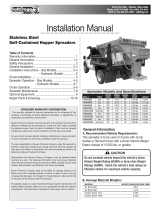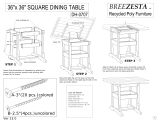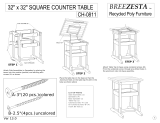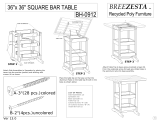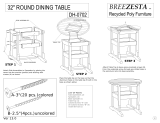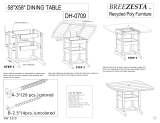Page is loading ...

July 15, 2023
Lit. No. 31446, Rev. 00
MARAUDER™ Hopper Spreader
#S150A, S220A, S300A, S400A, S500A
S150C, S220C, S300C, S400C, S500C
Installation Instructions
These Installation Instructions are for WESTERN® MARAUDER hopper spreaders
with serial numbers beginning with 230301 and higher.
Western Products, PO Box 245038, Milwaukee, WI 53224‑9538 • www.westernplows.com
A DIVISION OF DOUGLAS DYNAMICS, LLC
CAUTION
Read this document before installing
or operating the spreader.

Lit. No. 31446/31447/31448, Rev. 00 2 July 15, 2023
SAFETY
SAFETY DEFINITIONS
NOTE: Indicates a situation or action that can
lead to damage to your spreader and vehicle or
other property. Other useful information can also
be described.
WARNING/CAUTION LABELS
Become familiar with and inform users about the
warning and caution labels on the spreader.
NOTE: If labels are missing or cannot be read, see
your sales outlet.
NOTE: Translated safety labels are available.
Please contact your sales outlet.
CAUTION
Indicates a potentially hazardous situation
that, if not avoided, may result in minor or
moderate injury. It may also be used to alert
against unsafe practices.
WARNING
Indicates a potentially hazardous situation
that, if not avoided, could result in death or
serious personal injury.

Lit. No. 31446/31447/31448, Rev. 00 3 July 15, 2023
SAFETY
SAFETY LABELS – AUGER UNITS
• DO NOT exceed vehicle weight ratings (including GVWR & GAWR) with spreader and load.
• Turn spreader OFF before filling, adjusting, or cleaning.
• Bystanders to stay a minimum of 25 feet (7.6 m) away from operating spreader.
• DO NOT climb into or ride on spreader.
• Keep hands, feet, and clothing away from moving conveyor/auger and spinner.
• Read Owner's Manual before operating or
servicing spreader.
• Empty and clean spreader after every use.
CAUTIONWARNING
31594EN.01
Warning/Caution Label
(both sides of hopper)

Lit. No. 31446/31447/31448, Rev. 00 4 July 15, 2023
SAFETY
SAFETY LABELS – CHAIN DRIVE UNITS
• DO NOT exceed vehicle weight ratings (including GVWR & GAWR) with spreader and load.
• Turn spreader OFF before filling, adjusting, or cleaning.
• Bystanders to stay a minimum of 25 feet (7.6 m) away from operating spreader.
• DO NOT climb into or ride on spreader.
• Keep hands, feet, and clothing away from moving conveyor/auger and spinner.
• Read Owner's Manual before operating or
servicing spreader.
• Empty and clean spreader after every use.
CAUTIONWARNING
31594EN.01
Warning/Caution Label
(both sides of hopper)

Lit. No. 31446/31447/31448, Rev. 00 5 July 15, 2023
SAFETY
SAFETY PRECAUTIONS
Improper installation and operation could cause
personal injury and/or equipment and property
damage. Read and understand labels and the
Owner's Manual before installing, operating, or making
adjustments.
WARNING
• Driver to keep bystanders minimum of 25 feet
(7.62 m) away from operating spreader.
• Before working with the spreader, secure all
loose-tting clothing and unrestrained hair.
• Before operating the spreader, verify that all
safety guards are in place.
• Before servicing the spreader, wait for
conveyor or auger, and spinner to stop.
• Do not climb into or ride on spreader.
WARNING
Overloading could result in an
accident or damage. Do not exceed
GVWR or GAWR ratings as found
on the driver‑side vehicle door
cornerpost. See Loading section to determine
maximum volumes of spreading material.
WARNING
Do not install the control for this product in
the deployment path of an air bag. Refer to
vehicle manufacturer's manual for air bag
deployment area(s).
WARNING
Vehicles <10,000 lb (4536 kg) GVWR:
Obstructing the visibility from the vehicle's
rear camera could result in serious injury or
damage. An auxiliary camera system shall
be installed if the vehicle's rear camera is
removed or blocked.
CAUTION
If rear directional, CHMSL light, or brake
stoplights are obstructed by the spreader, the
lights shall be relocated, or auxiliary directional
or brake stoplights shall be installed.
Code Denition
YY 2‑Digit Year
MM 2‑Digit Month
DD 2‑Digit Day
LL 2‑Digit Location Code
XXXX 4‑Digit Sequential Number
ZZZZZ 5‑ to 7‑Digit Assembly PN
SERIAL NUMBER LABEL

Lit. No. 31446/31447/31448, Rev. 00 6 July 15, 2023
SAFETY
CAUTION
During the hopper installation we recommend
the addition of an OSHA compliant Backup
Alarm. This alarm is required for OSHA
governed employers.
CAUTION
• Do not operate a spreader in need of
maintenance.
• Before operating the spreader, reassemble
any parts or hardware removed for cleaning
or adjusting.
• Before operating the spreader, remove
materials such as cleaning rags, brushes,
and hand tools from the spreader.
• Before operating the spreader, read the
engine owner's manual, if so equipped.
• While operating the spreader, use auxiliary
warning lights, except when prohibited
by law.
• Tighten all fasteners according to the
Torque Chart. Refer to Torque Chart for the
recommended torque values.
CAUTION
Disconnect electric power and tag out if
required before servicing or performing
maintenance.
CAUTION
DO NOT leave unused material in
hopper. Material can freeze or solidify,
causing unit to not work properly.
Empty and clean after each use.
NOTE: Lubricate grease ttings after each use.
Use a good quality multipurpose grease.
FUSES
The electrical system contains several automotive‑style
fuses. If a problem should occur and fuse replacement
is necessary, the replacement fuse must be of the
same type and amperage rating as the original.
Installing a fuse with a higher rating can damage
the system and could start a re. Fuse ratings and
locations are shown in the Vehicle Harness Diagram
in the Electrical Components section of these
Instructions.
PERSONAL SAFETY
• Remove ignition key and put the vehicle in PARK
or in gear to prevent others from starting the
vehicle during installation or service.
• Wear only snug-tting clothing while working on
your vehicle or spreader.
• Do not wear jewelry or a necktie, and secure long
hair.
• Wear safety goggles to protect your eyes from
battery acid, gasoline, dirt, and dust.
• Avoid touching hot surfaces such as the engine,
radiator, hoses, and exhaust pipes.
• Always have a re extinguisher rated BC handy,
for ammable liquids and electrical res.
FIRE AND EXPLOSION
Be careful when using gasoline. Do not use gasoline
to clean parts. Store only in approved containers away
from sources of heat or ame.
WARNING
Gasoline is highly ammable and gasoline
vapor is explosive. Never smoke while
working on vehicle. Keep all open ames
away from gasoline tank and lines. Wipe up
any spilled gasoline immediately.

Lit. No. 31446/31447/31448, Rev. 00 7 July 15, 2023
SAFETY
CELL PHONES
A driver's rst responsibility is the safe operation of
the vehicle. The most important thing you can do
to prevent a crash is to avoid distractions and pay
attention to the road. Wait until it is safe to operate
Mobile Communication Equipment such as cell phones,
text messaging devices, pagers, or two‑way radios.
VENTILATION
BATTERY SAFETY
NOISE
Airborne noise emission during use is below 70 dB(A)
for the spreader operator.
VIBR ATION
Operating spreader vibration does not exceed 2.5 m/s2
to the hand‑arm or 0.5 m/s2 to the whole body.
CAUTION
Batteries normally produce explosive gases
which can cause personal injury. Therefore,
do not allow ames, sparks, or lit tobacco
to come near the battery. When charging or
working near a battery, always cover your
face and protect your eyes, and also provide
ventilation.
• Batteries contain sulfuric acid, which burns
skin, eyes, and clothing.
• Disconnect the battery before removing or
replacing any electrical components.
WARNING
Vehicle exhaust contains lethal fumes. Breathing
these fumes, even in low concentrations,
can cause death. Never operate a vehicle in
an enclosed area without venting exhaust to
the outside.
TORQUE CHART
1/4-20 10
91
54
1/4-28 12
11
71
5/16-1
81
50 212
5/16-2
41
70 240
3/8-16 269 376
3/8-24 29
74
20
7/16-1442
96
06
7/16-20
9/16-12
9/16-18
5/8-11
5/8-18
3/4-10
3/4-16
7/8-9
7/8-14 47
46
69
64
49
091-8
1-12 70
49
95
1/2-13
1/2-20
11.9
13.7
24.6
27.3
43.6
26.9
53.3
93
148
49.4
69.8
77.9
106.4
120.0
8.4
9.7
17.4
19.2
30.8
35.0
49.4
55.2
75.3
85.0
M6 x 1.00
M12 x 1.75
M8 x 1.25
M14 x 2.00
M10 x 1.50
M27 x 3.00
M22 x 2.50
M30 x 3.50
M24 x 3.00
M20 x 2.5011.1
19.5
38.5
67
107
7.7
613
778
1139
1545
450
428
562
796
1117
M33 x 3.50
M36 x 4.00
2101
2701
1468
1952
325
M16 x 2.00 231167
M18 x 2.50 318222
Recommended Fastener Torque Chart
Size Size
Torque (ft-lb)
Grade
5
Grade
8
Metric Fasteners Class 8.8 and 10.9
These torque values apply to fasteners
except those noted in the instructions.
Torque (ft-lb)
Grade
5
Grade
8
Size Size
Torque (ft-lb)
Class
8.8
Class
10.9
Torque (ft-lb)
Class
8.8
Class
10.9
Inch Fasteners Grade 5 and Grade 8
CAUTION
Read instructions before assembling.
Fasteners should be nger tight until
instructed to tighten according to the Torque
Chart. Use standard methods and practices
when attaching spreader, including proper
personal protective safety equipment.

Lit. No. 31446/31447/31448, Rev. 00 8 July 15, 2023
LOADING
These Installation Instructions cover vehicles that
have been recommended for carrying the hopper
spreader. Please see your local dealer for proper
vehicle applications.
CERTIFICATION
WARNING
Overloading could result in an accident or
damage. Do not exceed GVWR or GAWR as
found on the driver‑side cornerpost of vehicle.
WARNING
New untitled vehicle installation of a spreader
requires National Highway Trac Safety
Administration altered vehicle certication
labeling. Installer to verify that struck load of
snow or ice control material does not exceed
GVWR or GAWR rating label and complies
with FMVSS.
CAUTION
Read and adhere to manufacturer's
ice‑control material package
labeling, including Safety Data
Sheet requirements.
CAUTION
Never use wet materials or materials with
foreign debris with any of these spreaders.
These units are designed to handle dry, clean,
free-owing material.
SPREADER SPECIFICATIONS
MATERIAL WEIGHTS
Density
Material (lb/ft3)(lb/yd3)(kg/m3)
Salt 80 2160 1282
Sand 100 2700 1602
Material densities are approximate and are based on dry,
loose material. It is the responsibility of the operator to
know the weight of the material to be spread and the vehicle
carrying capacity.
Hopper
Model
Overall
Length
(in)
Hopper
Length (in)
Overall
Width
(in)
Bed
Height
(in)
Bed
Length
(in)
Empty
Weight
(lb)
S150C 107 84 50 32 76 587
S150A 111. 5 84 50 32 76 580
S220C 119.25 96 50 36 90 641
S220A 123 96 50 36 90 633
S300C 120.5 96 70 41 90 811
S300A 123 96 70 41 90 794
S400C 126.25 108 70 44 96 854
S400A 129 108 70 44 96 836
S500C 126.25 108 70 51 96 900
S500A 129 108 70 51 96 881
C = Chain Drive; A = Auger

Lit. No. 31446/31447/31448, Rev. 00 9 July 15, 2023
DETERMINING VEHICLE PAYLOAD
1. Install the hopper spreader and optional
equipment according to the Installation
Instructions.
2. Install or attach any other equipment that will be
on the vehicle while the hopper spreader will be in
use (step bumper, trailer hitch, snowplows, etc.).
Fill gas tanks.
3. Obtain the Gross Vehicle Weight Rating (GVWR),
Front Gross Axle Weight Rating (FGAWR), and
Rear Gross Axle Weight Rating (RGAWR) from
the certication label located inside the driver-side
door jamb or door.
4. With the occupants in the truck for normal hopper
spreader operation, weigh the vehicle to obtain
gross vehicle weight (GVW).
5. Subtract the GVW from the GVWR to determine
the available material payload.
6. Obtain the weight per cubic yard (lb/yd3) of the
desired material. Divide the weight into the
payload to determine the maximum volume of
material that can be carried.
7. Refer to the Load Volume table and diagrams to
determine the maximum ll level for the material.
8. Fill the hopper with material to the calculated level.
Reweigh the vehicle with occupants and verify that
the Loaded Gross Vehicle Weight, Front Gross
Axle Weight, and Rear Gross Axle Weight are less
than the vehicle's ratings.
9. Repeat Steps 6–8 for each type of material.
The worksheet for Determining Vehicle Payload (next
page) includes an example.
WARNING
Overloading could result in an accident or
damage. Do not exceed GVWR or GAWR
ratings as found on the driver‑side door
cornerpost of the vehicle. See Loading
section to determine maximum volumes of
spreading material.
LOADING
A
B
C
D
Hopper Model Load Volume (yd3)
ABCD
S150 1.9 1.6 1.1 0.7
S220 2.5 2.2 1.2 0.8
S300 3.4 3.1 2.5 1.0
S400 4.4 42.6 1.1
S500 5.4 52.6 1.1
LOAD VOLUME
A: Rounded Load
B: Struck Load
C: Second Bump
D: First Bump

Lit. No. 31446/31447/31448, Rev. 00 10 July 15, 2023
Determining Vehicle Payload Worksheet
Material Type Example:
Dry Salt
AEquipment installed when
vehicle was weighed
8' Stainless
Steel Hopper
Spreader
BFront Gross Axle Weight
Rating [FGAWR] (lb) 6000
CRear Gross Axle Weight
Rating [RGAWR] (lb) 7000
DGross Vehicle Weight
Rating [GVWR] (lb) 11,000
EGross Vehicle Weight [GVW],
empty (lb) – 7402
F Payload Available (lb) = 3598
GMaterial Density (lb/yd3)÷ 2160
HMaximum Volume (yd3)= 1.67
I
Maximum Material Fill Level,
approx. Refer to Load Volume
table and diagrams.
C
J
Loaded Front Gross Axle
Weight (lb) Must be less than
weight in Row B.
K
Loaded Rear Gross Axle
Weight (lb) Must be less than
weight in Row C.
L
Loaded Gross Vehicle Weight
[GVW] (lb) Must be less than
weight in Row D.
LOADING

Lit. No. 31446/31447/31448, Rev. 00 11 July 15, 2023
INSTALLING INVERTED V & MOUNTING THE SPREADER
NOTE: Periodically throughout the snow and ice
control season, verify that mounting devices
are secure.
INSTALL INVERTED V
1. Remove and retain the linchpins securing the top
screens. Remove the top screens and set them
aside.
2. The inverted V is mounted underneath the hopper
cross beams for shipping. Detach the inverted V
from the cross beams and set it aside.
3. Remove the chute from the hopper and set it on its
side. Two people are recommended for this step,
as the chute weighs more than 60 lb.
4. Remove the nuts from the cab‑end leg that is
already attached to the inverted V. Install the
supplied end cap bracket. Reinstall and tighten the
nuts.
5. Loosen the appropriate bolts, slide the
inverted V into position, then re‑tighten the bolts.
Secure the inverted V to the end cap with four
3/8" x 1‑1/2" carriage bolts, 3/8" washers, and
3/8" locknuts from the parts bag. Install the
carriage bolts from inside the hopper, with the
washers and locknuts on the outside.
Inverted V
3/8" x 1-1/2"
Carriage Bolts
End Cap
Attachment
Point
INSTALL TOP SCREEN BRACKETS
1. Install a top screen bracket at each end of
the spreader cross beams using the supplied
1/4" x 3/4" carriage bolts, 1/4" washers, and
1/4" locknuts.
2. Retain the linchpins supplied with the top screen
brackets. The top screens and linchpins will be
installed later.
1/4" x 3/4"
Carriage Bolt
1/4" Washer
1/4" Locknut
Spreader
Cross Beam
Top Screen
Bracket

Lit. No. 31446/31447/31448, Rev. 00 12 July 15, 2023
INSTALL HOPPER IN TRUCK BED
NOTE: Periodically throughout the snow and ice
control season, verify that mounting devices
are secure.
1. Remove the vehicle tailgate.
CAUTION
Before lifting, verify that the hopper is empty
of material. The lifting device must be able to
support the spreader's weight as shown in
the spreader specications table.
2. Remove the wooden dunnage from the hopper
legs.
3. Using slings or chains, lift the spreader by the four
diagonal corner rails and move it into the truck bed.
Use all four rails
when lifting.
4. Center the spreader from side to side. Shift the
spreader forward or backward to a position that
will allow the chute, once installed, to overhang
the rear of the truck and the bumper. With two
people, trial-t the chute to check for clearance.
CAUTION
Before drilling holes, check to be sure that no
vehicle wiring or other components could be
damaged.
5. Using the holes in the hopper support legs as a
template, mark mounting hole positions on the
truck bed. Move the spreader temporarily to allow
access, and drill 5/8" holes as marked.
NOTE: Pay special attention when drilling or
clamping dissimilar metals to aluminum bodies.
Galvanic corrosion can occur if not handled
properly. Contact vehicle manufacturer for
recommended attachment practices.
WARNING
Spreader shall be bolted to vehicle frame.
Do not rely on the tie‑down chains or straps
alone to hold spreader in vehicle.
6. Move the spreader back into position. Install the
spreader to the truck bed using four 5/8" Grade 5
bolts as required by the vehicle application,
5/8" at washers on both sides, and 5/8" locknuts.
(Fasteners supplied by installer.)
If the mounting holes are not directly over
the truck box supports, the truck bed must
be braced to the frame to prevent buckling or
deforming the truck bed. Accessory mounting
bars are available for installations that require
additional bracing. Contact your authorized dealer.
7. Remove the cable tie holding the wire harness
to the conveyor chain. Connect the vehicle‑side
harness to the hopper‑side harness.
8. Install the top screens, using the retained linchpins
to secure the screens to the previously installed
brackets.
Mounting Holes
(one per leg)

Lit. No. 31446/31447/31448, Rev. 00 13 July 15, 2023
Construct and Install Sill Spacer
1. Measure the distance from the hopper drive line
end to the front of the vehicle bed. Construct a
frame spacer from 2" x 8" lumber to t that area.
2. Install the frame spacer between the drive line end
of the hopper and the front of the vehicle bed.
MOUNTING THE SPREADER
Spacer
Built to Fit
CAUTION
Failure to install the frame spacer could result
in damage to the spreader and/or vehicle.
Fr
ont of
Tr
uck Bed
Measure distance.
18"
Fit to vehicle.
Meas
ured
Distance
INSTALL CHUTE
The chute comes in two lengths.
• Models S150C and S220C: Short chute
conguration is standard. The chute extends
14-3/4" below the truck bed and will t most
pickup trucks.
• Models S300C, S400C, and S500C: Long chute
conguration is standard. The chute extends
26-3/4" below the truck bed. Required for at bed
and dump truck installations.
Chain versions of chute shown.
Long Chute for
S300C, S400C & S500C Models
Short Chute for
S150C & S220C Models

Lit. No. 31446/31447/31448, Rev. 00 14 July 15, 2023
INSTALL CHUTE
Conrm/Adjust Chute Length
Ideal spinner height is 12"–18" above the ground. For
some installations the chute length may need to be
adjusted to achieve the desired spinner height. If no
length adjustment is required, go to "Install Chute to
Spreader."
Changing Short Chute to Long Conguration
Extending a short chute requires installation of a
Chute Extension Kit (available from your authorized
dealer).
Changing Long Chute to Short Conguration
The chute must be separate from the spreader.
1. Remove the ten cap screws from the middle and
top cover (as shown in illustration below), then
remove the covers. Retain the top cover and six
cap screws for reassembly.
2. Remove seventeen carriage bolts from the chute
extension. Set aside nine carriage bolts and
locknuts that will be used later during reassembly.
Reattach with
6 Cap Screws
Remove
10 Cap Screws
Carriage Bolts
(8 each side + 1 inside
)
3. Measure/mark the amount of shaft stick out from
the bearing (on the bottom of the chute). Then
unbolt the shaft from the shaft coupler and loosen
the set screws and remove the shaft and spinner
disc.
4. The shaft will need to be cut down to 5/8" above
the middle hole or a short shaft purchased from
an authorized dealer.
5. Reinstall nine of the carriage bolts into the short
chute conguration. Install the cut shaft into the
bearing with set screws and tighten fasteners
with the correct amount of the shaft stick out as
measured in Step 3.
If a new shaft is purchased, install it so that the
spinner shaft is contacting the motor shaft; then
tighten the set screw.
6. Reinstall the top cover with six cap screws
Install Tie‑Down Straps
Install tie‑down straps (to be provided by the installer)
from the tie‑down loops on the spreader body to the
truck frame. Use one strap per loop, pulling diagonally
away from the hopper body.
NOTE: Periodically throughout the snow and ice
control season, verify that mounting devices
are secure.

Lit. No. 31446/31447/31448, Rev. 00 15 July 15, 2023
Install Chute to Spreader
1. Two people are recommended for this step. Pick up
the chute from each side and slide the chute hinges
over the hopper hinges. Line up the hinge pivot holes.
2. Insert a 1/2" x 8‑1/2" chute pin on each side and
secure with a 3/32" x 2‑1/4" cotter pin.
The chute can pivot on either pin to provide access to
the feed area of the hopper. The chute is designed to
swing open in one direction only. It cannot be opened
without disconnecting the hopper harness cable.
3. Connect the chute motor plug to the hopper harness
plug.
Auger Spreaders
Hinge
Pivot Holes
Hinge
Pivot Holes
Chute
Pivot Pins
Chain Spreaders
Hinge
Pivot Holes
Hinge
Pivot Holes
Chute
Pivot Pins
INSTALL CHUTE

Lit. No. 31446/31447/31448, Rev. 00 16 July 15, 2023
WIRING INSTRUCTIONS
Spreaders are shipped from the factory with the
spreader harness wired to the motor and spreader
module.
To properly wire the hopper spreader, follow this
recommended installation sequence:
1. Install the vehicle battery cable and control
harness included with the spreader.
2. Install the cab control as described under "Cab
Control Installation."
NOTE: Use dielectric grease on all electrical
connections.
Vehicle Battery Cable Installation
1. Before beginning this installation, remove the
battery cables from the vehicle battery.
2. Using the 1/4" x 3/4" cap screws, 1/4" at washers,
and 1/4" locknuts, mount the fuse holder near
the vehicle battery so that the 22" battery cable
can be installed from the POSITIVE (+) battery
terminal to the fuse holder. Install the fuse into the
fuse holder and hand tighten the nuts.
NOTE: Accessory 50" or 90" cables may be installed
in place of the standard 22" cable for applications
requiring a longer vehicle battery cable.
3. Attach one end of the 22" battery cable to the fuse
holder so that the ring terminal is on top of the
fuse. Replace the lock washer and nut.
4. Lay out a path for routing the vehicle battery cable
from the rear of the vehicle bed to the vehicle
battery. Make sure that the path avoids any hot,
sharp, or moving parts of the vehicle. Routing will
vary from vehicle to vehicle.
5. Route the vehicle battery cable as laid out in Step 4.
6. Using cable ties, secure the battery cable to
the vehicle. Verify that the harness cannot drop
onto the road when it is disconnected from the
spreader.
7. Attach the vehicle battery cable red wire to the
other fuse holder stud so that the ring terminal is
on top of the fuse. Replace the lock washer and
nut.
8. Torque the fuse holder nuts to 106–159 in‑lb and
snap the fuse holder cover into place.
9. Attach the other end of the 22" battery cable to
the POSITIVE (+) battery post.
10. Attach the vehicle battery cable black wire to the
NEGATIVE (–) battery terminal.
NOTE: When using the accessory 50" or 90"
battery cables, connect the black wire from the
vehicle battery cable to a ground bolt on the
vehicle frame or the engine. Clean away any paint
or dirt to ensure a good ground connection
WIRING AND HARNESS INSTRUCTIONS

Lit. No. 31446/31447/31448, Rev. 00 17 July 15, 2023
WIRING AND HARNESS INSTRUCTIONS
5. Insert a rubber grommet into the hole.
6. Route the harness as laid out in Step 2.
7. Secure the vehicle control harness to the vehicle.
8. Attach the red wire to a switched accessory
circuit.
Cab Control Installation
1. Conrm that the chosen cab control mounting
position will not interfere with other equipment or
allow unintentional starting of the spreader.
2. Install the vehicle side of the mounting bracket
using three #10 x 3/8" Phillips head tapping
screws.
3. Install the control side of the bracket to the control
using four #8 x 3/8" Phillips head machine screws.
Vehicle Control Harness Installation
1. Plug the vehicle harness into the spreader harness.
2. Lay out a path for routing the vehicle control
harness from its attachment point on the vehicle
battery cable into the cab of the vehicle. Make
sure that the path avoids any hot, sharp, or moving
parts of the vehicle. Routing will vary from vehicle
to vehicle.
3. Choose a cab control mounting location that can
be reached by the harness. The location must
be within easy reach of the vehicle operator
without restricting access to vehicle controls or
instrumentation.
Do not mount the control in areas prohibited
by the vehicle manufacturer for reasons of
crashworthiness. See the vehicle's body builder's
book, owner's manual, or service manual for
details. The shaded portions in the illustration
below show the most commonly restricted areas.
4. Drill a 5/8" hole in the re wall so that the vehicle
control harness can reach the desired cab control
location.
CAUTION
Before drilling any holes, check both sides
of the material for any wires, fuel lines, fuel
tanks, etc., that may be damaged by drilling.
CAUTION
Do not alter, modify, or install additional
components in shaded areas shown below.
Failure to comply may interfere with airbag
deployment or cause injury to operator in an
accident.
Cont
rol Side
(C
ontrol not shown.)
Vehicle Side
#10 x 3/8"
Tapping
Screws
#8 x 3/
8"
Machine
Screws

Lit. No. 31446/31447/31448, Rev. 00 18 July 15, 2023
Install Control Harness
1. Install the control side of the bracket to the vehicle
side using 1/4" x 1/2" Phillips head machine
screws, 1/4" nylon shoulder washers, 1/4" lock
washers, and 1/4" locknuts.
2. Plug the vehicle control harness into the cab control.
Harness Plug Cover
Install the supplied harness plug cover by slipping the
loop end of the cover over the harness plug.
WIRING AND HARNESS INSTRUCTIONS
CENTER HIGH‑MOUNTED STOPLIGHT
(CHMSL)
An LED center high‑mounted stoplight is standard
equipment on all stainless steel hopper spreaders.
The orange wire from the spreader vehicle harness
is for the CHMSL. Splice the orange wire into an
existing CHMSL circuit wire tap. Location of the tap
varies according to specic vehicle model, and may be
located either in the cab or in the rear of the vehicle.
Always use the tap provided by the OEM.
DO NOT splice the orange wire into the wire coming
o the stoplight switch by the brake pedal. Splicing at
the stoplight switch may aect transmission shifting,
cruise control, or other vehicle functions.
For vehicles with a tap along the frame rail or at
the rear cross member:
1. Cut the tape holding the orange wire where it exits
the convoluted tubing.
2. Pull out the orange wire to the location where the
vehicle CHMSL tap is located. Cut a small
V notch in the tubing for the wire to exit. Pull the
wire through the V notch and tape the tubing on
each side of the exit point.
3. Trim any excess length from the orange wire and
splice into the vehicle tap.
INSTALL ACCESSORIES
To install any of the accessory kits that are available
for the steel hopper spreaders, follow the instructions
included with each kit.
(Control not shown.)
1/4" Shoulder
Washer
1/4" Lock
Washer
1/4" Locknut
1/4" x 1/2"
Machine Scre
w

Lit. No. 31446/31447/31448, Rev. 00 19 July 15, 2023
ELECTRICAL COMPONENTS
+
_
Battery
Cab Control
4-Way Connector
Connectors
18 ga Shielded
Twisted-Pair Cable
4 ga Red
18 ga Black
4 ga Black
Connect to
spread
er harness.
To
Vehicle CHMSL Signal
(tap located in cab)
To Vehicle CHMSL Signal
(tap located in rear of vehicle)
Not Used
100A
Fuse
6 ga Red
18 ga Red
To
Vehicle Switched Accessory
BRN
ORN
ORN
8-Pin
Connector
Vehicle Control Harness
Vehicle
Cable
Assembly
VEHICLE HARNESS DIAGRAM

Lit. No. 31446/31447/31448, Rev. 00 20 July 15, 2023
ELECTRICAL COMPONENTS
Conveyor Switch
Acc. Work
Light Switch
Acc. Connection Block
CHMSL
(Orange & Black)
Motor
Harness
Chute
Harness
Plate Light
Main
Harness
Acc Taps
Blue – Vibrator
Orange – Prewet
White – Strobe
Gray – Work Light
Conveyor Switch
ELECTRICAL CONTROL BOX DIAGRAM – AUGER SPREADER
/
